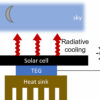High-frequency wireless communication systems such as 5G millimeter wave (mmWave) and beyond are of particular interest to consumers as they can deliver data with extremely high speed and provide an upgraded experience to existing wireless communication systems. Despite the many advantages of mmWave communication, there are several basic challenges associated with using it.
Santosh Ganji, a computer engineering doctoral student in the Department of Electrical and Computer Engineering at Texas A&M University, is working with his faculty advisor Dr. P.R. Kumar to design novel beam management practices for 5G wireless technology to address these issues and provide a reliable solution for mmWave communication.
Current mmWave communication devices use narrow directional beams to maintain connection, which means that the transmitter and the receiver must continuously adapt their beam direction to maintain alignment as the user moves or walks around. Additionally, the human body blocks the mmWave communication link from the cell tower to the wireless device. To combat this, both the transmitter and receiver must maintain a backup non-line of sight beam reflected off any ambient surfaces to preserve link during blockage.
Beam management, which encompasses this beam adaptation and blockage recovery, is vital to keep high-frequency communication systems working efficiently.
Ganji has developed two separate protocols for mmWave beam management. His first, BeamSurfer, continuously aligns the beams used by the cell tower and wireless device so that they point at each other with minimal overhead and without requiring any special sensors. It also circumvents pedestrian blockage by maintaining a backup non-line of sight beam that reflects off of interior walls to preserve a link during blockage. Terra, his other developed tool, does the same but is specifically designed for outdoor environments. Instead of maintaining a non-line of sight beam that reflects off of interior walls, Ganji utilizes the ground as a reflective surface. If a user moves far away from a cell tower or is permanently blocked from it, then Terra also seamlessly does “handover,” i.e., switches the user through a different cell tower.
Current research to address this problem utilizes cameras or sensors to monitor a user’s location, which then allows the beams to be pointed toward each other. But Ganji’s technology is able to take measurements within the signal without any additional equipment.
“These protocols are designed to be usable in current 5G and future cellular technologies,” he said. “We anticipate our work can be utilized in any future directional communication system architecture.”
Provided by
Texas A&M University
Citation:
Enabling 5G millimeter wave wireless communication through innovative beam management (2022, July 6)


